Numerical Simulation of Tensile Behavior of Corroded Aluminum Alloy 2024 T3 Considering the Hydrogen Embrittlement
Abstract
:1. Introduction
2. The Multi-Scale Approach
2.1. Basic Considerations
- For the macro-scale model, a random distribution of exfoliated areas, throughout the whole specimen, is considered. The higher degree of damage observed for the side surface of the specimens, as compared to the degree of damage observed at top surfaces, was also considered.
- The metallographic analysis performed in [2] revealed that the deepest exfoliated areas also have the largest diameter. Based on this observation, it was assumed that the largest and deepest exfoliated areas have the most significant effects on the mechanical properties of the corroded material.
- The shape of the exfoliated areas was irregular. For simplicity reasons, all of them were considered to have the shape of a truncated cone.
- The following assumptions, derived from the evaluation of experimental findings within the HEZ, and considering the simulation capabilities, were taken:
- The observation of a quasi-cleavage transition zone below the intergranular fracture zone, in pre-corroded tensile specimens, in previous works [2,3,21,23], is attributed to the presence of trapped hydrogen in the region under the pit bottom. Also, nanoindentation hardness values are lowest at the initial measurements (0 μm). Therefore, the HEZ was considered to start immediately below the bottom of the pits and exfoliated areas for all cases.
- Following the measurements of nanoindentation hardness after 24 h of exposure, each correspondent numerical HEZ was divided in three parts of equal dimensions and progressively increasing mechanical properties, for all simulated periods.
- Even though the dimensions of the exfoliated areas were considered to differ from top to side surfaces, the dimensions of the HEZ were kept constant for all cases.
2.2. The Representative Unit Cell (Micro-Scale)
2.2.1. Experimental Tests and Findings
2.2.2. Geometry and Finite Element Model
2.2.3. Simulation of the Mechanical Behavior of the Representative Unit Cells
2.3. The Tension Specimen (Macro-Scale)
2.3.1. Geometry and Finite Element Model
2.3.2. Simulation of Corrosion Damage
- Corrosion damage is modeled by assigning the mechanical behavior of the RUCs with their respective HEZs to specific sets of elements of the specimen.
- The number of degraded sets of elements is extracted from the pit distributions presented in [2]. The groups of degraded elements are randomly placed in the specimen, according to the pit density observed in the cited work after each corrosion period.
- The volume of each group of elements is equal to the volume of the respective RUC model for each case.
- The depth of each group is equal to the depth t of the respective RUC for each case.
3. Numerical Results
4. Conclusions
- The employment of a multi-scale approach is suitable for the simulation of the tensile behavior of 2024 T3 aluminum alloy pre-corroded specimens, accounting for both the metallographic features of corrosion damage and the effect of HE on diminishing local mechanical properties.
- The insertion of the degraded properties of the hydrogen embrittled zone into the RUC, upgrading the existing model which accounted only for geometrical features of corrosion damage, is sufficient to simulate the experimentally observed diminishing elongation to fracture, given the simplifications performed in determining the HEZ’s mechanical properties.
- The model could be applied for the simulation of the mechanical behavior of any corroded structural part in which there is the possibility of occurrence of HE (e.g., a mechanically-fastened panel exposed to marine or industrial environments) made from the aluminum 2024 T3 alloy.
Acknowledgments
Author Contributions
Conflicts of Interest
References
- Davis, J.R. Corrosion in Aluminum and Aluminum Alloys; ASM International: Almere, The Netherlands, 1999. [Google Scholar]
- Pantelakis, S.; Setsika, D.; Chamos, A.; Zervaki, A. Corrosion damage evolution of the aircraft aluminum alloy 2024 T3. Int. J. Struct. Integr. 2016, 7, 25–46. [Google Scholar] [CrossRef]
- Petroyiannis, P.V.; Kamoutsi, E.; Kermanidis, A.T.; Pantelakis, S.G.; Bontozoglou, V.; Haidemenopoulos, G.N. Evidence on the corrosion-induced hydrogen embrittlement of the 2024 aluminium alloy. Fatigue Fract. Eng. Mater. Struct. 2005, 28, 565–574. [Google Scholar] [CrossRef]
- Pantelakis, S.G.; Chamos, A.N.; Setsika, D. Tolerable corrosion damage on aircraft aluminum structures: Local cladding patterns. Theor. Appl. Fract. Mech. 2012, 58, 55–64. [Google Scholar] [CrossRef]
- Setsika, D.; Tserpes, K.; Pantelakis, S. Numerical simulation of tensile behavior of corroded aluminum alloy 2024 T3. Int. J. Struct. Integr. 2015, 6, 451–467. [Google Scholar] [CrossRef]
- Vasco, M.C.; Chamos, A.N.; Pantelakis, S.G. Effect of environment’s aggressiveness on the corrosion damage evolution and mechanical behavior of AA 2024-T3. Fatigue Fract. Eng. Mater. Struct. 2017, 40, 1551–1561. [Google Scholar] [CrossRef]
- Ishihara, S.; Saka, S.; Nan, Z.Y.; Goshima, T.; Sunada, S. Prediction of corrosion fatigue lives of aluminium alloy on the basis of corrosion pit growth law. Fatigue Fract. Eng. Mater. Struct. 2006, 29, 472–480. [Google Scholar] [CrossRef]
- Kappatos, V.; Chamos, A.N.; Pantelakis, S.G. Assessment of the effect of existing corrosion on the tensile behaviour of magnesium alloy AZ31 using neural networks. Mater. Des. 2010, 31, 336–342. [Google Scholar] [CrossRef]
- Cerit, M.; Genel, K.; Eksi, S. Numerical investigation on stress concentration of corrosion pit. Eng. Fail. Anal. 2009, 16, 2467–2472. [Google Scholar] [CrossRef]
- Cerit, M. Numerical investigation on torsional stress concentration factor at the semi elliptical corrosion pit. Corros. Sci. 2013, 67, 225–232. [Google Scholar] [CrossRef]
- Hingorani, R.; Pérez, F.; Sánchez, J.; Fullea, J.; Andrade, C.; Tanner, P. Loss of ductility and strength of reinforcing steel due to pitting corrosion. In Proceedings of the 8th International Conference on Fracture Mechanics of Concrete and Concrete Structures FraMCoS-8, Toledo, Spain, 11–14 March 2013; pp. 2009–2018. [Google Scholar]
- Liao, M.; Bellinger, N.; Komorowski, J. Modeling the effects of prior exfoliation corrosion on fatigue life of aircraft wing skins. Int. J. Fatigue 2003, 25, 1059–1067. [Google Scholar] [CrossRef]
- Pidaparti, R.M.; Rao, A.S. Analysis of pits induced stresses due to metal corrosion. Corros. Sci. 2008, 50, 1932–1938. [Google Scholar] [CrossRef]
- Pidaparti, R.M.; Patel, R.K. Investigation of a single pit/defect evolution during the corrosion process. Corros. Sci. 2010, 52, 3150–3153. [Google Scholar] [CrossRef]
- Rajabipour, A.; Melchers, R.E. A numerical study of damage caused by combined pitting corrosion and axial stress in steel pipes. Corros. Sci. 2013, 76, 292–301. [Google Scholar] [CrossRef]
- Turnbull, A.; Horner, D.A.; Connolly, B.J. Challenges in modelling the evolution of stress corrosion cracks from pits. Eng. Fract. Mech. 2009, 76, 633–640. [Google Scholar] [CrossRef]
- Turnbull, A.; Wright, L.; Crocker, L. New insight into the pit-to-crack transition from finite element analysis of the stress and strain distribution around a corrosion pit. Corros. Sci. 2010, 52, 1492–1498. [Google Scholar] [CrossRef]
- Kermanidis, A.T.; Stamatelos, D.G.; Labeas, G.N.; Pantelakis, S.G. Tensile behaviour of corroded and hydrogen embrittled 2024 T351 aluminum alloy specimen. Theor. Appl. Fract. Mech. 2006, 45, 148–158. [Google Scholar] [CrossRef]
- Kamoutsi, H.; Haidemenopoulos, G.N.; Bontozoglou, V.; Petroyiannis, P.V.; Pantelakis, S.G. Effect of prior deformation and heat treatment on the corrosion-induced hydrogen trapping in aluminium alloy 2024. Corros. Sci. 2014, 80, 139–142. [Google Scholar] [CrossRef]
- Rodopoulos, C.A.; Pantelakis, S.G.; Papadopoulos, M.P. The effect of ultrasonic impact treatment on the fatigue resistance of friction stir welded panels. J. Mater. Eng. Perform. 2009, 18, 1248–1257. [Google Scholar] [CrossRef]
- Petroyiannis, P.V.; Kermanidis, A.T.; Papanikos, P.; Pantelakis, S.G. Corrosion-induced hydrogen embrittlement of 2024 and 6013 aluminum alloys. Theor. Appl. Fract. Mech. 2004, 41, 173–183. [Google Scholar] [CrossRef]
- Pantelakis, S.G.; Daglaras, P.G.; Apostolopoulos, C.A. Tensile and energy density properties of 2024, 6013, 8090 and 2091 aircraft aluminum alloy after corrosion exposure. Theor. Appl. Fract. Mech. 2000, 33, 117–134. [Google Scholar] [CrossRef]
- Kamoutsi, H.; Haidemenopoulos, G.N.; Bontozoglou, V.; Pantelakis, S. Corrosion-induced hydrogen embrittlement in aluminum alloy 2024. Corros. Sci. 2006, 48, 1209–1224. [Google Scholar] [CrossRef]
- Larignon, C.; Alexis, J.; Andrieu, E.; Odemer, G.; Blanc, C. The contribution of hydrogen to the corrosion of 2024 aluminium alloy exposed to thermal and environmental cycling in chloride media. Corros. Sci. 2013, 69, 211–220. [Google Scholar] [CrossRef] [Green Version]
- Larignon, C.; Alexis, J.; Andrieu, E.; Lacroix, L.; Odemer, G.; Blanc, C. Combined Kelvin probe force microscopy and secondary ion mass spectrometry for hydrogen detection in corroded 2024 aluminium alloy. Electrochim. Acta 2013, 110, 484–490. [Google Scholar] [CrossRef] [Green Version]
- Larignon, C.; Alexis, J.; Andrieu, E.; Lacroix, L.; Odemer, G.; Blanc, C. Investigation of Kelvin probe force microscopy efficiency for the detection of hydrogen ingress by cathodic charging in an aluminium alloy. Scr. Mater. 2013, 68, 479–482. [Google Scholar] [CrossRef] [Green Version]
- American Society for Testing and Materials. Standard Test Method for Exfoliation Corrosion Susceptibility in 2XXX and 7XXX Series Aluminum Alloys (EXCO Test) 1. ASTM Int. 2007, 1, 1–8. [Google Scholar] [CrossRef]
- Oliver, W.C.; Pharr, G.M. Measurement of hardness and elastic modulus by instrumented indentation: Advances in understanding and refinements to methodology. J. Mater. Res. 2004, 19, 3–20. [Google Scholar] [CrossRef]
- Barnoush, A.; Vehoff, H. In situ electrochemical nanoindentation: A technique for local examination of hydrogen embrittlement. Corros. Sci. 2008, 50, 259–267. [Google Scholar] [CrossRef]
- Birnbaum, H.K.; Sofronis, P. Hydrogen-enhanced localized plasticity—A mechanism for hydrogen-related fracture. Mater. Sci. Eng. A 1994, 176, 191–202. [Google Scholar] [CrossRef]
- Bouzakis, K.-D.; Michailidis, N. An accurate and fast approach for determining materials stress–strain curves by nanoindentation and its FEM-based simulation. Mater. Charact. 2006, 56, 147–157. [Google Scholar] [CrossRef]
- Sawa, T. Correlation between Nanoindentation Test Result and Vickers Hardness. In Proceedings of the IMEKO 2010 TC3, TC5 and TC22 Conferences, Pattaya, Thailand, 22−25 November 2010. [Google Scholar]
- ANSYS, Inc. Release 11.0 Documentation for ANSYS; ANSYS, Inc.: Canonsburg, PA, USA, 2006. [Google Scholar]


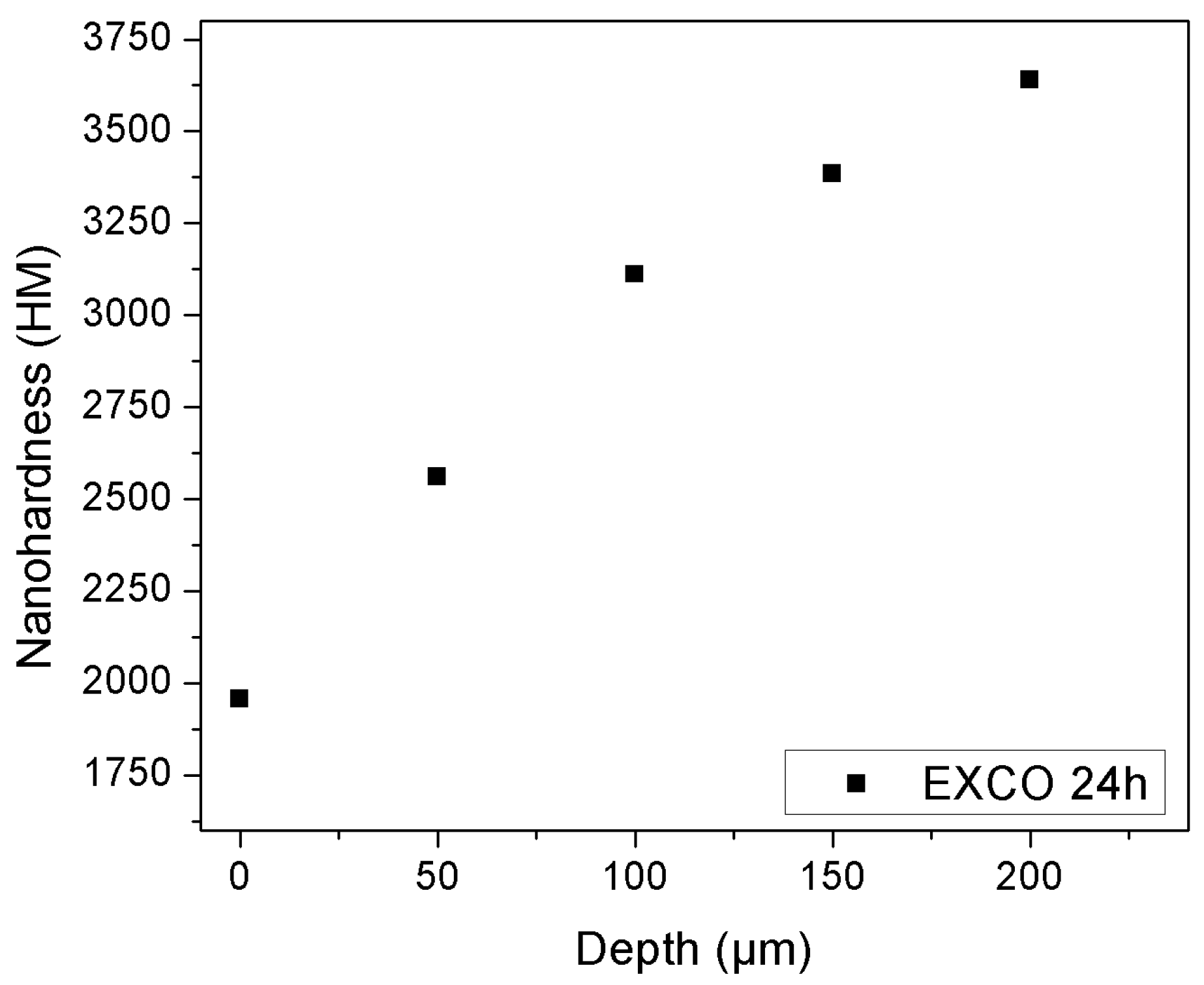
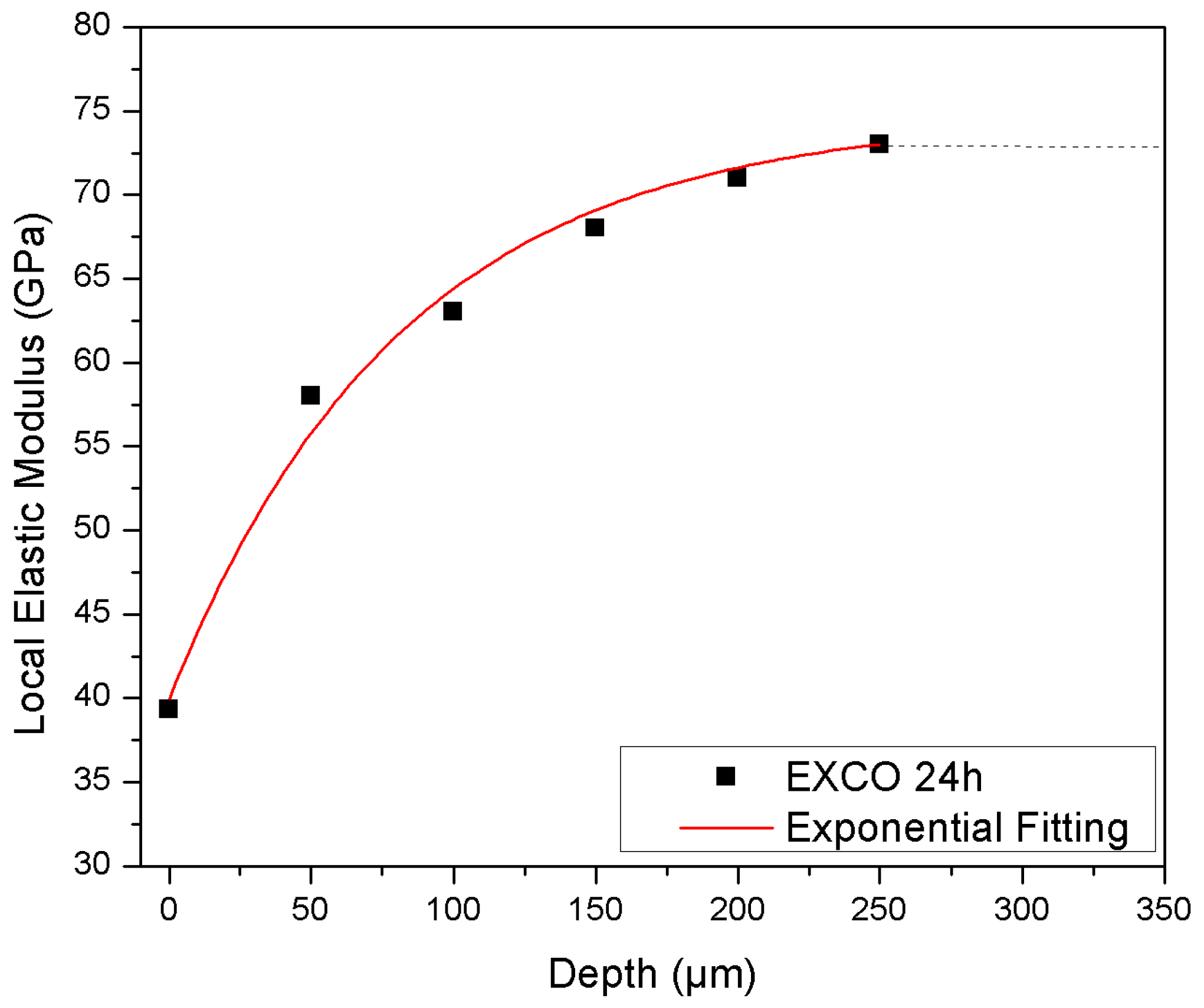
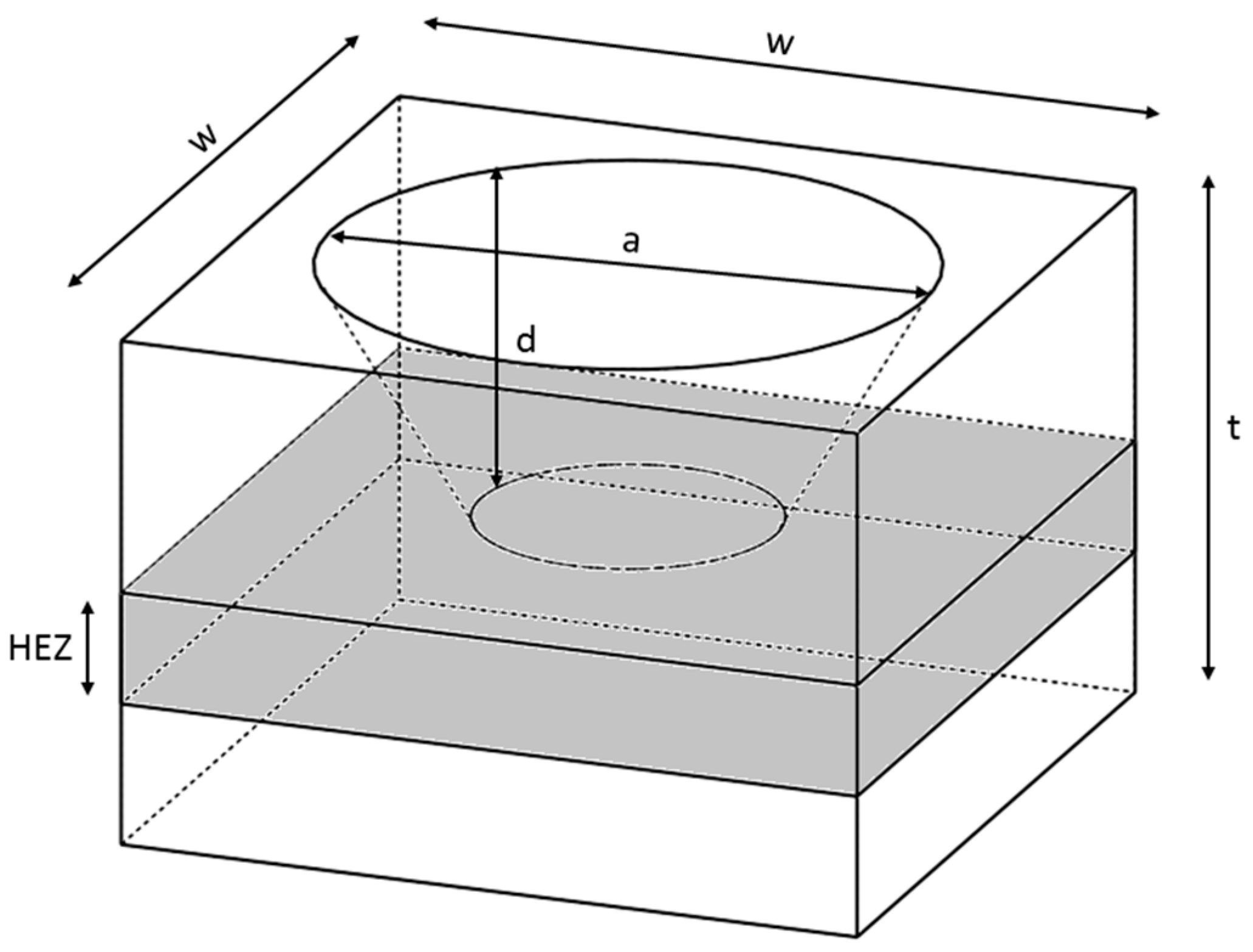
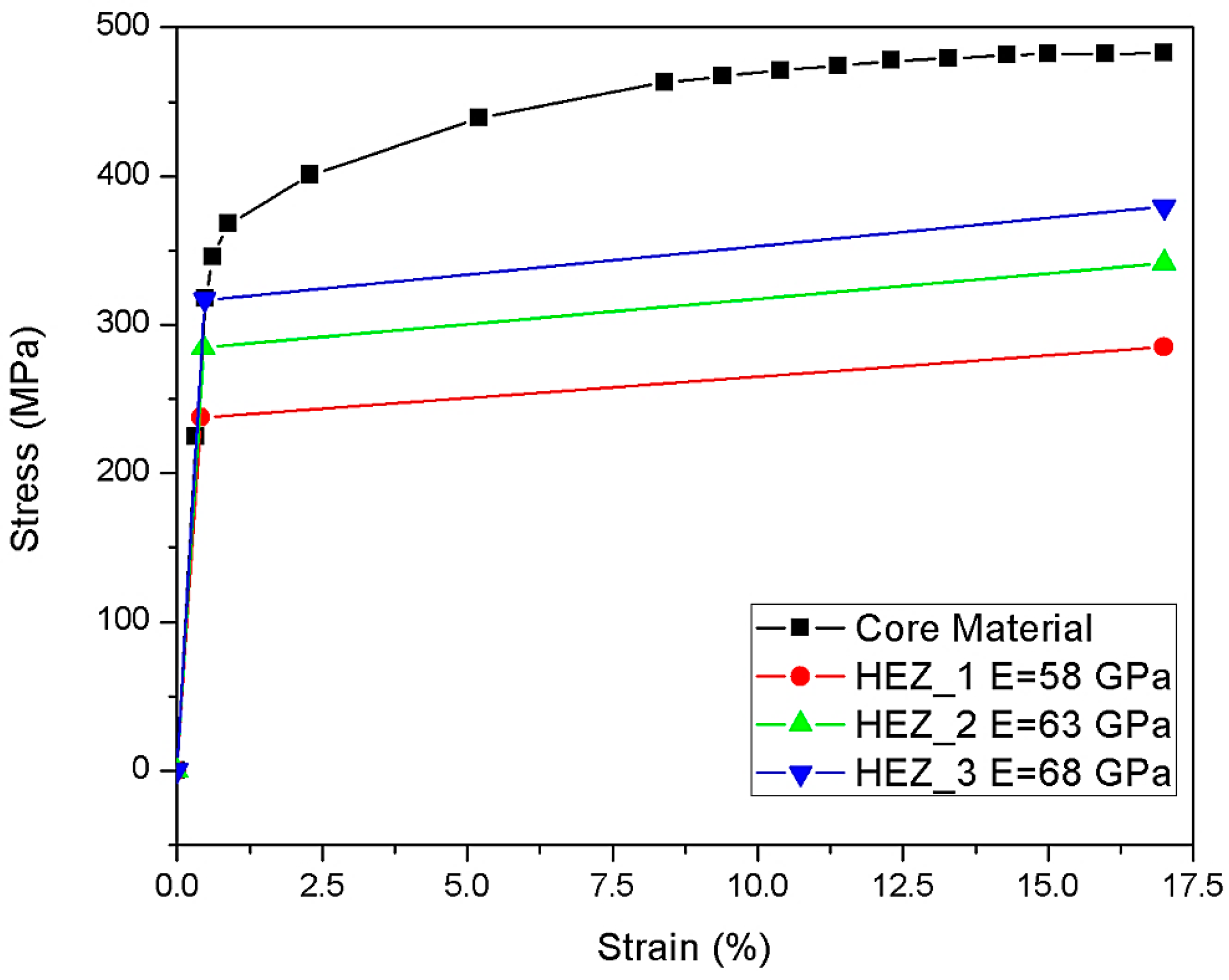
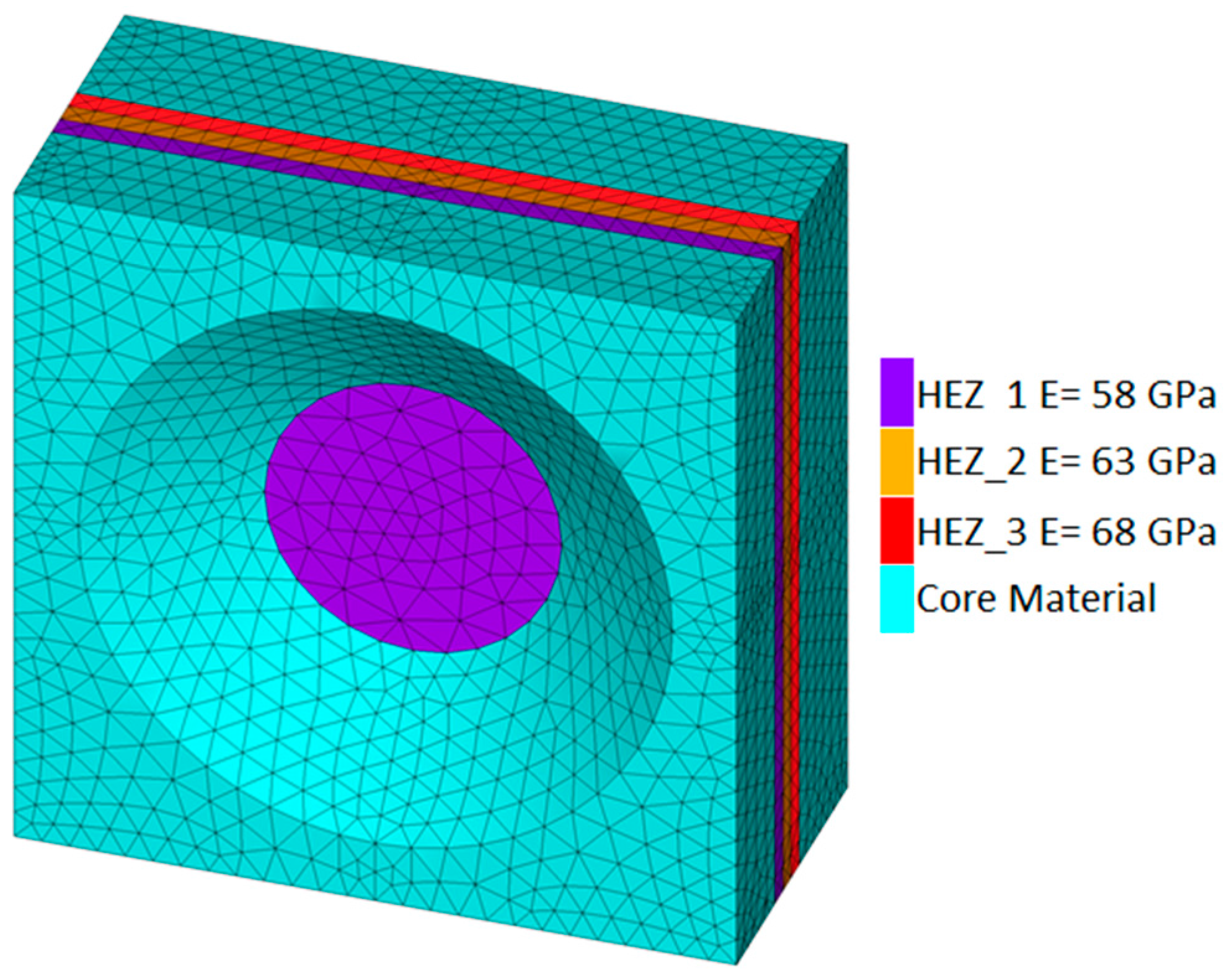

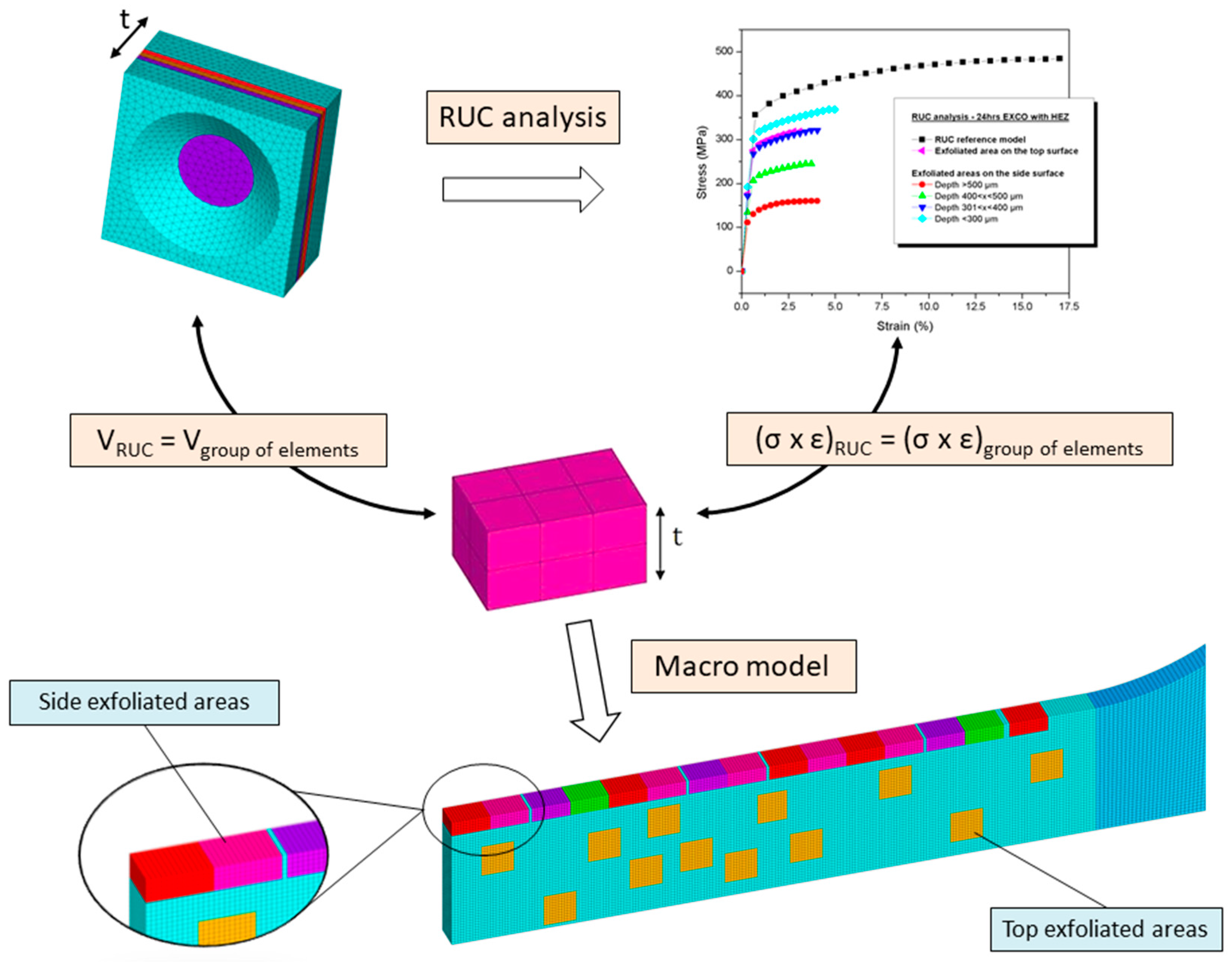

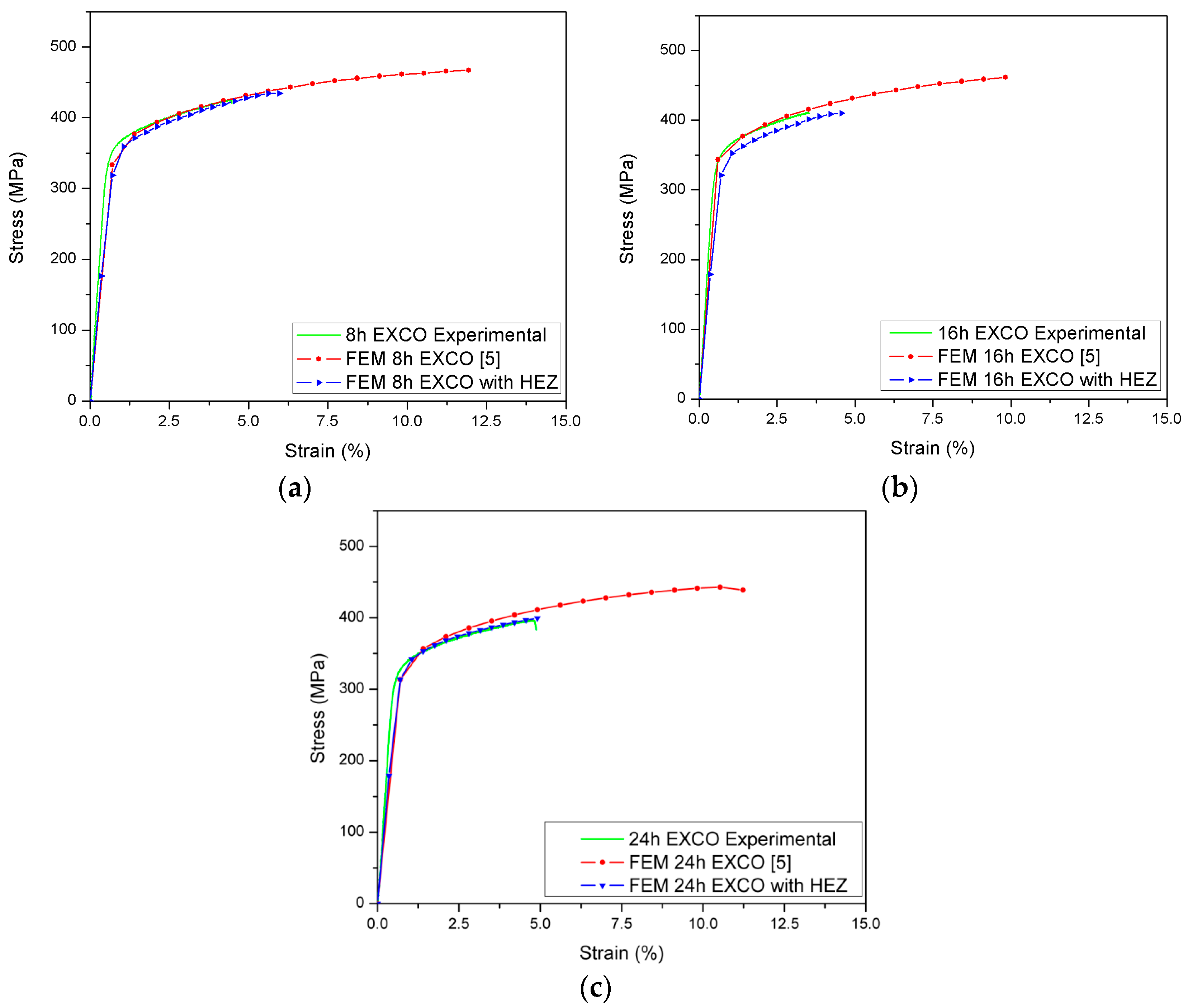

| EXCO Time (h) | Nanoindentation Hardness (HM) | Local Elastic Modulus (GPa) |
|---|---|---|
| 8 | 1906.8 | 35.5 |
| 16 | 2093.6 | 39.7 |
| EXCO Time (h) | Depth (μm) | Local Elastic Modulus (GPa) | ||
|---|---|---|---|---|
| x0 | x1 | y0 | y1 | |
| 8 | 0 | 100 | 35.5 | 71 |
| 16 | 0 | 150 | 39.7 | 71 |
| a = 39.96, b = 0.42, k = −0.01. | ||||
| EXCO (h) | Cubic Part | Depth Range (μm) [2] | Embedded Pit | ||
|---|---|---|---|---|---|
| w (μm) | t (μm) | d (μm) | a (μm) | ||
| 8 | 790 | 480 | >100 | 165 | 177 |
| 91 ≤ d ≤ 100 | 94 | 240 | |||
| 81 ≤ d ≤ 90 | 84 | 194 | |||
| 71 ≤ d ≤ 80 | 76 | 174 | |||
| 61 ≤ d ≤ 70 | 65 | 133 | |||
| 16 | 1300 | 580 | Mean values | 203 | 921 |
| 24 | 1480 | 680 | Mean values | 233 | 1217 |
| EXCO (h) | Cubic Part | Depth Range (μm) [2] | Embedded Pit | ||
|---|---|---|---|---|---|
| w (μm) | t (μm) | d (μm) | a (μm) | ||
| 8 | 790 | 480 | >400 | 463 | 762 |
| 351 ≤ d ≤ 400 | 377 | 668 | |||
| 301 ≤ d ≤ 350 | 325 | 754 | |||
| 251 ≤ d ≤ 300 | 276 | 561 | |||
| 201 ≤ d ≤ 250 | 224 | 469 | |||
| 151 ≤ d ≤ 200 | 175 | 336 | |||
| 101 ≤ d ≤ 150 | 127 | 247 | |||
| ≤ 100 | 80 | 209 | |||
| 16 | 1300 | 580 | >500 | 564 | 1286 |
| 401 ≤ d ≤ 500 | 443 | 1056 | |||
| 301 ≤ d ≤ 400 | 345 | 1044 | |||
| ≤300 | 243 | 850 | |||
| 24 | 1480 | 680 | >500 | 660 | 1450 |
| 401≤ d ≤500 | 452 | 1340 | |||
| 301≤ d ≤400 | 357 | 960 | |||
| ≤300 | 245 | 731 | |||
© 2018 by the authors. Licensee MDPI, Basel, Switzerland. This article is an open access article distributed under the terms and conditions of the Creative Commons Attribution (CC BY) license (http://creativecommons.org/licenses/by/4.0/).
Share and Cite
Vasco, M.C.; Tserpes, K.; Pantelakis, S.G. Numerical Simulation of Tensile Behavior of Corroded Aluminum Alloy 2024 T3 Considering the Hydrogen Embrittlement. Metals 2018, 8, 56. https://doi.org/10.3390/met8010056
Vasco MC, Tserpes K, Pantelakis SG. Numerical Simulation of Tensile Behavior of Corroded Aluminum Alloy 2024 T3 Considering the Hydrogen Embrittlement. Metals. 2018; 8(1):56. https://doi.org/10.3390/met8010056
Chicago/Turabian StyleVasco, Marina C., Konstantinos Tserpes, and Spiros G. Pantelakis. 2018. "Numerical Simulation of Tensile Behavior of Corroded Aluminum Alloy 2024 T3 Considering the Hydrogen Embrittlement" Metals 8, no. 1: 56. https://doi.org/10.3390/met8010056




